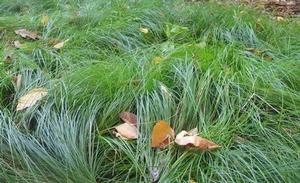New Moon Nurseries
Carex leavenworthii
Lawn Sedge
Native to North America
FIRST IMPRESSIONS: Carex leavenworthii is a clumping perennial sedge with very narrow dark green leaves. In late spring small dense green clusters of flower spikes are held above the leaves. Plants occur in partly sunny to shady mesic or dry woods. This sedge has great landscape potential as a woodland groundcover and is a natural as a lawn alternative.
HABITAT & HARDINESS: Carex leavenworthii is native to Ontario and to the eastern and central United States from New York to Florida and west to Wisconsin, Nebraska, Kansas, Oklahoma and Texas.
Plants are indigenous to mixed oak forests, dry sandy woods, forest clearings and woodland edges, dry grasslands, roadsides, road banks and lawns.
Hardy from USDA Zones 6-9
PLANT DESCRIPTION: Carex leavenworthii grows in dense clumps of very narrow dark green foliage.
Leaves are evergreen and up to 12” long and about 1/8” wide.
In late spring each slender culm bears a dense scaly head-like inflorescence. The heads contain 3-8 spikelets packed closely together. Each spikelet contains 6-10 spreading or ascending beaked pale green ovate perigynia.
The heads mature into brown conical clusters of round achenes that are dispersed by mid-summer.
This sedge is 6-12” tall with an equal spread.
CULTURAL & MAINTENANCE NEEDS: Carex leavenworthii prospers in open dry woods. Plants will survive in sunny sites but they take on a yellowish color and need at least 1-2” of irrigation per month.
This sedge performs well in a wide range of soils including sandy, clay, seasonally flooded or alkaline. Established plants are drought and heat tolerant, pest resistant and unpalatable to deer and other herbivores.
In garden situations, plants can be cut to the ground during late summer to encourage fresh new growth that will last through winter.
Plants do not have rhizomes and so they proliferate by seeding. If this is an issue, cut or mow them to the ground before seed have matured.
LANDSCAPE USES: Carex leavenworthii is a handsome fine textured Groundcover or Lawn Substitute for the Shade Garden. This sedge is lovely as an Accent or when Grouped or Massed with spring wildflowers, low growing bulbs or ferns. Plants provide Erosion Control and Winter Interest and are appropriate for Deer Resistant Plantings, Low Maintenance Plantings, Restoration Projects and Wildlife Gardens.
This sedge is an excellent native substitute for the popular Asian groundcovers Liriope muscari and Ophiopogon japonicus.
COMPANION & UNDERSTUDY PLANTS: Suitable garden companions for Carex leavenworthii could include Aster divaricatus, Danthonia spicata, Eupatorium colestinum, Monarda fistulosa, Polystichum acrostichoides, and Solidago caesia.
If a substitute is needed, Carex texensis could work in many situations.
TRIVIA: Plant Carex leavenworthii on 10” centers to create a woodland lawn that can be mown on a high (3-4”) setting 1-3 times each year. Keep the planting area moist until the sedge is established and water as needed thereafter. Plantings tolerate light foot traffic but if the lawn is traversed daily, stepping stones should be added. This is a clump forming sedge rather than a runner, but it will seed in and fill bare spots.
This species is also known as Carex cephalophora var. angustifolia or
Carex cephalophora var. leavenworthii. The specific epithet honors Melines Conklin Leavenworth (1796-1862), a botanist and Army surgeon.
Sedge seed provide sustenance to various birds and squirrels
Height:
6-12 inSpread:
6-12 InchesSpacing:
12-18 inUSDA Hardiness Zone:
6-9Carex leavenworthii Characteristics
Attracts Wildlife
- Songbirds
- Pollinators
- Butterflies
Attributes
- Interesting Foliage
- Evergreen
- Drought Tolerant
- Naturalizing
- Ground Cover
Exposure
- Full Shade to Full Sun
Deer Resistant
- Deer Resistant
Flowering Months
- April
Foliage Color
- Green
Grass Season
- Cool Season Grass
Groundcover Foot-Traffic Tolerances
- Moderate
Growth Rate
- Fast
Lawn Replacement or Groundcover
- Groundcover
- Lawn Replacement
Season of Interest (Foliage)
- Fall
- Summer
- Spring
- Winter
Soil Moisture Preference
- Moist
Interesting Notes:
Sedge seed provide sustenance to various birds and squirrels,
